Site menu:
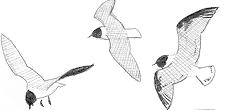
April 2010 Newsletter
North-west Estuaries.
Voluntary Wardens Wanted for Neston Reedbed.
March Bird News.
Forthcoming Events.
Latest Newsletter.
North-west Estuaries

Both the national Wetlands Bird Survey 2007/08 Report and the Dee Estuary Wetland Bird Survey Annual Report for 2008/09 have recently been published. If you are a WeBS counter you will shortly get your free copies. For the non-WeBS counters the national WeBS report is available on-line and if you would like a copy of the Dee Estuary report enquire at Inner Marsh Farm RSPB, there will be a charge for the latter.
Rather than do my normal short summaries of the reports I thought this year, as a one off, I would compare data for four of the most important estuaries in the North-West of England - that is the Dee estuary, Mersey estuary, Ribble estuary and Morecambe Bay South (MBS - i.e. the area which is in Lancashire). I would have included the Solway Firth but I do not have any comprehensive data for that estuary. This first article is on three Wildfowl species, there will be a second article on Waders in a month or two.
I should make clear that the interpretation of the data is entirely my own, any mistakes are mine. The article has not been peer reviewed so should just be viewed as my own amateurish attempt at describing the year to year variations and comparisons of counts. More controversially, perhaps, I have not drawn graphs in the conventional manner of just showing the annual max, but have instead averaged the two highest counts for each year (WeBS 'year' being Jul to Jun). I feel this can sometimes give a better feel for true overwintering numbers as it evens out, somewhat, one off unusually high counts. In most cases it hasn't actually made a big difference to the shape of the graphs - just smoothed them out a bit.
Teal
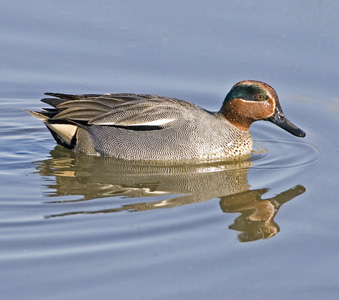
Nationally, numbers of Teal have soared since WeBS began 45 years ago, although they have plateaued out and even decreased a bit in the past 10 years probably due to birds staying on the continent during the recent mild winters. Counts on the Dee have shown a decrease over the past 10 years but nothing too dramatic. In contrast, Mersey numbers show a steep decline. If the graph below went back a further 20 years the decline would be seen as even more dramatic, the Mersey estuary actually holds the record count for the UK with 35,000 in December 1981, in contrast the peak count in 2008 was only 2,072. Numbers on the Ribble have been fairly stable over the past ten years whilst those on MBS have increased - thus demonstrating that there appears to have been no medium term decline of this species in North-West estuaries generally, other than on the Mersey.
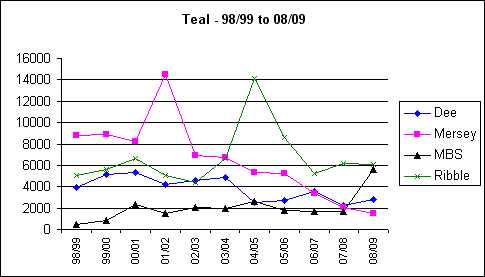
You will notice two very high counts during the past ten years. There were five figure counts on the Mersey from Nov to Jan in the winter of 2001/02, almost a return to the heydays of the 1980s. On the Ribble the 2004/05 peak occurred in Oct, the count of 19,567 the highest ever there. Presumably these were birds on passage, counts in Sep and Nov that winter being at normal levels. What I find intriguing is why were these two particular estuaries targeted by the birds, and in different years? The counts give no indication that there was a general influx into the area during those two winters, and there didn't appear to be any dispersal into the other estuaries after the peak number had passed. But maybe we shouldn't be surprised by the occasional large influx as vast numbers breed in northern Europe, it has recently been estimated around 3 million breed in western Russia alone (Cabot)!
Pintail
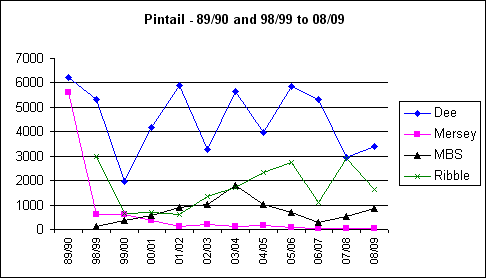
Although varying a lot from winter to winter nationally there has been no long term trend up or down since the early 1970's, although numbers have decreased quite sharply in the last three years. The Dee estuary continues to be the most important site in the country for this species and again numbers fluctuate quite widely from year to year. The start of the graph above jumps back ten years to show the dramatic reduction in Pintail numbers on the Mersey. Remarkably, like Teal, the Mersey holds the record for the highest ever count in this country with 18,450 on Nov 23rd 1980, now peak numbers are less than 100 (for more details see the October 2007 Newsletter). Numbers on the Ribble also fluctuate but there appears to have been no overall trend up or down over the past 10 years, during some winters numbers approach that present on the Dee and it might well be that there is interchange between the two sites. MBS counts tend to be lower with an average of around 800 to 1,000.
Shelduck
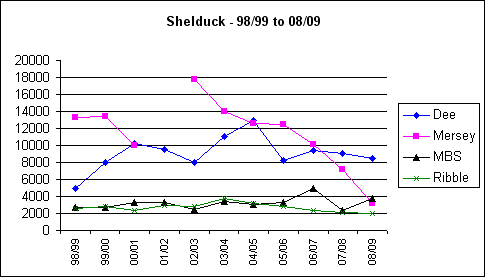
Nationally, although numbers have shown a decline since their peak in the mid-1990s counts now seem to have stabilised over the past six winters. The highest ever count of Shelduck on the Dee Estuary was made in Oct 2004, numbers seem to have benefited from the moulting site on the nearby Mersey Estuary. It was first noted in 1995 that birds on the Mersey Estuary were peaking in summer, the following year 7,000 were present in Aug and subsequently it was established that birds were moulting here. Highest counts were reached in 2002 (no count took place in 2001 due to foot & mouth). Since then there appears to have been a sharp decline of numbers moulting here, although that might be at least partly due to recent incomplete coverage when counting the Mersey for WeBS, and also the timing of the counts is crucial; it may be that birds have been at the moult site between counts. Nevertheless it is a fact that the peak count in the summer of 2002 was 19,810 in contrast to the peak count in the summer of 2008 of only 4,237. However, there are indications that some birds may now be moulting on the Dee Estuary, there were 7,383 present in August 2008. MBS and Ribble Estuary have much smaller numbers, although counts for the whole of Morecambe Bay (rather than just the southern half) usually reach a max of 6,000 to 9,000, making it the third most important site in the UK behind the Dee and Mersey.
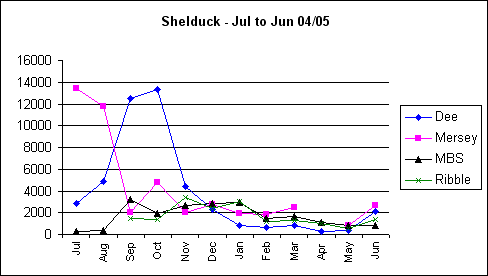
I've included the above graph for Jul to Jun 2004/05 as it shows very nicely the transfer of birds from the Mersey, where they moulted during the summer, to the Dee for the autumn. That particular winter there was a very sharp drop in numbers after October on the Dee estuary, so much so that for the second half of the winter hardly any were present. Where did these birds go to after the autumn peak? There certainly appeared to be no dispersal to the Ribble or MBS which I had expected to see. If we had a full set of data for all the sites across the country we might be able to work out where they went!
WeBS (Wetland Bird Survey) data in this article should not be used elsewhere in any way without permission of the WeBS Office. To access official WeBS data please contact the WeBS Secretariat - BTO, The Nunnery, Thetford, Norfolk IP 24 2 PU www.bto.org.
Sources of Information:
1. Cheshire and Wirral Bird Reports: 1980, 1981, 1989, 1990, 1998 to
2008.
2. Colin E. Wells and Neil Friswell, A Major New Shelduck (Tadorna
Tadorna) Moult Site, Cheshire & Wirral Bird Report 1998.
3. Lancashire Bird Reports: 1998 to 2008.
4. Waterbirds in the UK (WeBS Report), reports from 1998/99 to 2007/08.
5. Neil Friswell and Colin Wells, Dee Estuary WeBS Annual Report,
2008/2009.
6. David Cabot, Wildfowl, New Naturalist no. 110 (Collins), 2009.
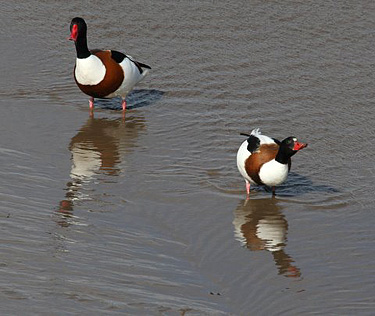
Voluntary Wardens Needed to Protect Neston Reed Bed
 Once again the
RSPB are organising voluntary wardening at Neston Reed Bed, the scheme will
begin near the end of March and run through until the end of May. Wardening will take
place each evening in order to protect this important habitat from
disturbance. I know in the past this scheme has
attracted birders who have realised what a good opportunity this location is
for some serious birdwatching with the possibility of seeing migrating
Ospreys and Marsh Harriers, large numbers of Little Egrets flying in to
roost, Bearded Tits, Hen Harriers, Short-eared Owls and the numerous birds
which breed in the reed bed. If you are interested please contact Geoff Robinson (Geoffrey.Robinson@rspb.org.uk),
telephone 0151 336 7681.
Once again the
RSPB are organising voluntary wardening at Neston Reed Bed, the scheme will
begin near the end of March and run through until the end of May. Wardening will take
place each evening in order to protect this important habitat from
disturbance. I know in the past this scheme has
attracted birders who have realised what a good opportunity this location is
for some serious birdwatching with the possibility of seeing migrating
Ospreys and Marsh Harriers, large numbers of Little Egrets flying in to
roost, Bearded Tits, Hen Harriers, Short-eared Owls and the numerous birds
which breed in the reed bed. If you are interested please contact Geoff Robinson (Geoffrey.Robinson@rspb.org.uk),
telephone 0151 336 7681.
March Bird News
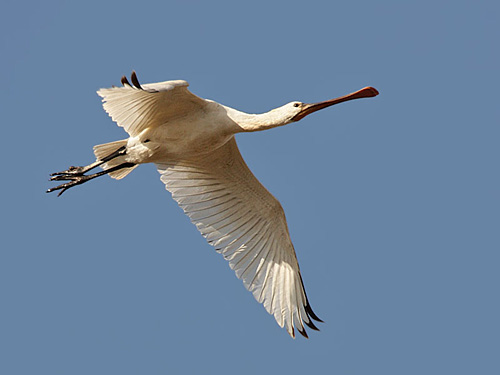
We've certainly had a good year so far for high tides completely covering the marsh at Parkgate with at least five in total, including three in March. As you would expect the two at the beginning of the month were best for birds with all the hoped for species showing - Water Rail, Jack Snipe, Short-eared Owl, Hen Harrier, Marsh Harrier, Merlin, Peregrine and Spoonbill. At the end of the month there were less birds but three Little Gulls were an unexpected bonus, blown in by a strong north-westerly. The same winds brought in Little Gulls along the North Wirral coast including 45 at New Brighton. In contrast, March 1st was flat calm which meant a good count of Great Crested Grebes off Dove Point was possible with a total of 379.
The Spring migration got off to a good start with an early Wheatear, and there was an early Willow Warbler on the 19th skulking in the bushes on top of the cliff at Thurstaston. Several days of southerly winds no doubt helped to push the birds along a bit, including 1,150 Meadow Pipits counted by the Hilbre Bird Observatory on 25th.
| Species | 2010 | Location (2010) | 2009 | 2008 |
|---|---|---|---|---|
| Wheatear | 10th March | Leasowe Gunsite | 14th March | 13th March |
| White Wagtail | 12th March | West Kirby | 4th March | 9th March |
| Sand Martin | 18th March | Inner Marsh Farm and New Brighton | 15th March | 16th March |
| Swallow | 18th March | Hoylake and New Brighton | 16th March | 15th March |
| Willow Warbler | 19th March | Thurstaston | 31st March | 31st March |
| House Martin | 30th March | Inner Marsh Farm | 30th March | 11th April |
| Swift | 8th April | 22nd April | ||
| Whitethroat | 11th April | 11th April | ||
| Cuckoo | 26th April | 23rd April |
Among other migrants were three Garganey on Burton Marsh which arrived on the 3rd, I think this might be the earliest ever multiple sighting for this species in Cheshire and Wirral, although we have had much earlier single records including a female in January 2003! An early Osprey flew over Wallasey on the 22nd. The first Gannets of the year were off Hilbre on the 9th and the first Sandwich Tern off Leasowe on the 19th.

There were some good counts of birds early in the month with 6,000 Herring Gull off Hilbre and 10,000 Oystercatcher on Middle Eye on the 2nd. 40,000 Knot were seen to fly out of the estuary on the 10th, these may well have been on their way to Morecambe Bay where many moult into breeding plumage before moving on to their breeding grounds.
Other notable birds was a Red Kite flying down the estuary from Point of Ayr on the 1st, with another seen flying at both Leasowe Lighthouse and Thurstaston on the 18th, it seems to have hung around as it was seen twice more before the end of the month. Black Redstarts were at Flint and Hilbre, where the Velvet Scoter was still present for most of the month. A Great White Egret was photographed flying over Burton Point on the 14th.
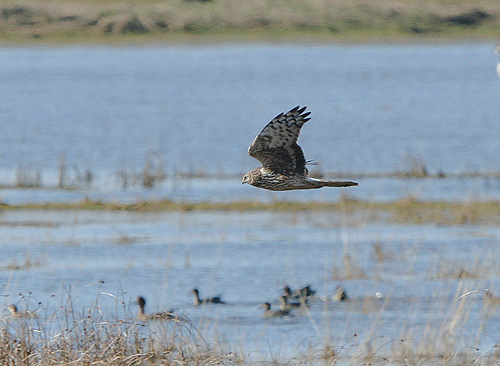
Richard Smith.
What to expect in April
Spring migration really picks up this month, getting up early on a lovely spring morning is an excellent way to see these migrants. Some days we can expect large 'falls' of birds including 100 Wheatear at Leasowe or Heswall, and maybe the same number of White Wagtail on Hoylake or Gronant beaches. Whimbrel will be passing through and we should also see a few Ring Ouzels. You will have a good chance of seeing Marsh Harriers on their way north as they often hang around the marshes for a day or two but Ospreys usually just pass over quickly so it's a question of being in the right place at the right time.
April is often a good month for rarities - last year we a Red-rumped Swallow and Stone Curlew, both in the Leasowe Lighthouse/Carr Lane area. Avocet numbers should build up to 20 or so at Inner Marsh Farm and may be several hundred non-breeding Black-tailed Godwit, most of the breeding adults will already be in Iceland.
Out to sea we should have our first Common and Little Terns, with a few birds returning to their local breeding colonies. Some years we can get several hundred Gannets out in the Irish Sea on their way north - a spectacular sight! Little Gulls will be passing along the north Wirral coast on their way to Crosby/Seaforth where they then pass overland to the North Sea on their way to the Baltic.
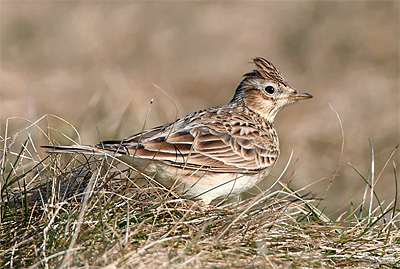
Forthcoming Events
April Highest Spring Tides (Liverpool)
Also see
Tides page.
1st April, 13.26hrs (BST), 9.7m.
Forthcoming Events
Organised by the
Wirral Ranger Service ,
Flintshire Countryside Service and/or the RSPB:
All these events and walks have bird interest, even those not advertised
specifically for birdwatching. No need to book for these events unless
specified - please check below.
Also see 'Wingspan', a Diary of Birdwatching
Events for Wirral and the North Wales Coast.
Wednesday 14th April - Migrant Watch, 9am start.
Join the Rangers at Wirral Country Park for a guided walk across
Thurstaston’s countryside and foreshore in search of spring migrants such
as Wheatears and Swallows. There may be some winter stragglers like Redwing
and Fieldfare still around. No need to book, meet at the
Visitor Centre, Thurstaston. For info
ring 151 648 4371.
Friday 16th April -
Point of Ayr Migrants - 10am start.
The Point of Ayir is a fantastic mixture of habitats and is an outpost on
the Dee Estuary. Therefore, it is a brilliant place to look for unusual
and rare birds as the migration season really kicks in. We will be on the
look out for whimbrel, terns and other birds as they move from their
wintering areas. Meet at the Smuggler's Inn Car Park, Talacre, dress
appropriately for the weather and bring your binoculars if you have any.
0151 336 7681 for details.
Saturday 17th Apr - Up with the Lark at Ness Gardens - 7am start.
Take an early morning walk in wonderful surroundings as we listen to the
dawn chorus at Ness Botanic Gardens (led by RSPB Wardens) followed by
breakfast. £7.95 per person phone 0151 353 0123 to reserve a place as
booking is essential.
Saturday 17th April, The Big Dipper
- a 2010 Explore Wirral’s Biodiversity event, 2 – 3.30pm.
2010 is the International Year of Biodiversity so to celebrate the
Rangers and the Wirral Country Park Recording Group will be running a
series of events focussing on Wirral’s wealth of wildlife. First up is a
pond dip. We’ll go for a short walk around the Nature Ponds before
dipping in the Visitor Centre pond. All children must be accompanied by a
parent. Booking essential ring 0151 648 4371.
Friday 30th April -
Hilbre for Migrants.
Join the Rangers and the RSPB Wardens for a guided wildlife walk over the
sands to the Hilbre Islands. We’ll be staying over the high tide and will
be on the Island for six hours. So, plenty of time to spot some spring
migrants and say goodbye to the last of the winter waders. As we are
staying over-tide you’ll need to wrap up warm and bring a packed lunch.
Booking essential, with a £2 charge. Ring 0151 648 4371.
Sunday 2nd May, Dawn Chorus over the
Heswall Heath, 4.30am–6.30am.
Rise with the Lark and listen to the delights of Nature’s Chorus over
these heathlands. This walk will be led by the Rangers and members of
Wirral Wildlife and is suitable for all the family to enjoy. Sorry no
dogs.
Meet at Cleaver Heath car park, Oldfield Road off Quarry Road West and
Telegraph Road, Heswall. Booking essential. Ring 0151 648 4371.
Saturday 8th May - The Big Breakfast, 7 – 9.30am.
Here’s a treat for the early riser! Join the Rangers at
Wirral Country Park for an early
morning nature ramble looking for warblers that have just arrived from
Africa to breed in our lush hedgerows. When the birding is done we’ll be
calling in to GJ’s Café for a well deserved full English breakfast! There
is a £4 advance charge for this event and booking is essential. Ring 0151
648 4371.
Saturday 8th May, Bluebells, Birdsong and
Burton Mere (RSPB), 2pm start.
Gorse Wood in the spring is awash with a carpet of bluebells and alive
with a chorus of birdsong. This exclusive walk is also a chance to catch
up with the ongoing developments at Burton Mere. Booking is essential but
cost is FREE call 0151 336 7681 to reserve your spot.
Saturday 15th May, Up with the Lark at Ness Gardens, 7am - 9am.
Another chance to experience the early morning chorus at Ness Botanic
Gardens. A guided tour of the outstanding gardens by an RSPB warden
followed by sumptuous breakfast in the cafe. Pre-booking essential, phone
0151 353 0123 - £7.95 p.p.
|
 |
The blank (UK) Birding Webring is a collection of quality birding web sites that are based in the United Kingdom. Visit the webring homepage for more information, or A complete list of all the sites in the webring is available by clicking here. previous site in ring : random site in ring : next site in ring |